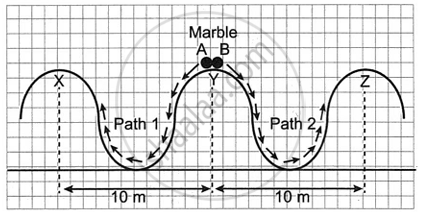Advertisements
Advertisements
Question
Shows a uniform metre scale of weight W supported on a fulcrum at the 60 cm mark by applying the effort E at the 90 cm mark.
- State with reason whether the weight W of the scale is greater than, less than or equal to the effort E.
- Find the mechanical advantage in an ideal case.

Solution
Because the metre scale remains uniform
∴ Its mass per unit length is same and its wt. W acts at the 50 cm mark.
(a) ∴ W × (60 – 50) = E (90 – 60) 10W = 30 E
W = `(30 E) /10` = 3E
∴ The reason why the weight of the scale is larger than the effort is because the distance of the weight of the metre scale from the fulcrum F (10 cm) is less than the effort's (30 cm). As a result, the weight of the scale is greater than the effort.

(b) In this case,
Effort arm = (90 - 60) cm = 30 cm
Load arm = (60 - 50) cm = 10 cm
Ideal Mechanical advantage (M.A) = `"effort arm"/"load arm"`
= `(30 cm)/(10 cm)`
M.A. = 3 cm
APPEARS IN
RELATED QUESTIONS
What do you understand by an ideal machine?
How does ideal machine differ from a practical machine ?
How is mechanical advantage related to the velocity ratio for an ideal machine?
State one reason why is mechanical advantage less than the velocity ratio for an actual machine.
A pair of scissors is used to cut a piece of a cloth by keeping it at a distance 8.0 cm from its rivet and applying an effort of 10 kgf by fingers at a distance 2.0 cm from the rivet.
- Find:
- the mechanical advantage of scissors and
- the load offered by the cloth.
- How does the pair of scissors act: as a force multiplier or as speed multiplier?
The figure below shows the use of a lever.

- State the principle of moments as applied to the above lever.
- To which class of lever does it belong ? Give an example of this class of lever.
- If FA = 10 cm, AB = 490 cm calculate:
- the mechanical advantage and
- the minimum effort required to lift the load (= 50 N).
State the principle of an ideal machine.

Two identical marbles A and B are rolled down along Path 1 and Path 2 respectively.
Path 1 is frictionless and Path 2 is rough.
- Which marble will surely reach the next peak?
- Along which path/s the mechanical energy will be conserved?
- Along which path/s is the law of conservation of energy obeyed?
How is mechanical advantage related to velocity ratio for a practical machine?
Give two reasons for a machine not to be 100% efficient?
